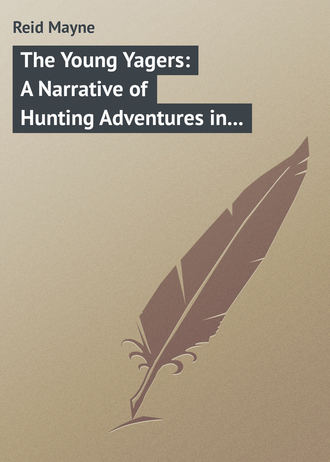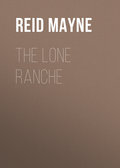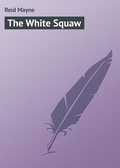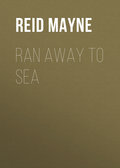
Майн Рид
The Young Yagers: A Narrative of Hunting Adventures in Southern Africa
Chapter Twenty Four.
The Odd Cock
During all this time Congo watched the movement of the flock as well as the sun in his eyes would allow him.
He noticed that the cock that had been feeding apart from the rest had now got close up to them, – within a few yards; but that the others had arisen at his approach, and, stretching out their long necks, appeared to regard him as a stranger. After a moment all seven turned, as if alarmed at something, and ran away – the odd cock running after, though falling a little in the rear.
The flock only went for twenty yards or so, and then halted, as if they had got over their slight alarm.
The old cock again stalked slowly up, now and then dropping his head to the ground, and pecking up a grain or two of something on his way.
When he got close to the flock a second time, they seemed to take fresh alarm, ran twenty yards farther, and again stopped.
It appeared as if the old cock was a stranger to the rest, and that they considered his presence an intrusion!
Again he approached them, and again they made a short run; this time not in a direct line, but in a circle around him, so that they came back nearly to their original ground. This time, however, only the five hens ran off. Both the cocks remained near the spot; but the movements of these now puzzled Congo not a little.
One of them had squatted down, just as they had been first observed, while the other ran about in very small circles, occasionally fluttering his white plumes, and acting altogether like a drunken man!
After a few minutes the manoeuvres of all appeared to change. The one that had seated himself appeared to lie down and remain quiet, while he that had the “staggers” squatted down not far off; and presently a hen came running up and sat down beside him; so that now there remained upon their feet only one cock and four of the hens.
The whole scene puzzled Congo, who was not from an ostrich country, and was but indifferently acquainted with the habits of these birds. No doubt, thought he, the creatures were about some game of their own, such as he had often seen with the “kooran” and partridges.
There were others than Congo puzzled at what was passing among the ostriches.
Klaas and Jan, who had reached their stations sooner than the rest, and who had been observing the odd actions of the birds, were both puzzled as to what they were about; and a little later Hans and Arend had a surprise, and were equally at a loss what to think of the game of “fits and starts” that was going on upon the plain.
But Hans and Arend had not much time to observe. They had both gone far round, and they expected soon to see Hendrik and Groot Willem gallop out from the timber, so they kept their eyes in that direction.
They were not disappointed. A few minutes after both were seen to shoot forth at full speed, and ride in diverging lines, so as to approach each other, and at the same time get nearer to the ostriches.
As soon as the others saw them, the whole five, Congo included, showed themselves on the open ground, all making towards a common centre – the spot where the ostriches were.
The hunters were now more surprised than ever. As they rode forward, they perceived that several of the great birds were seated, or lying upon the ground. They were basking, no doubt; but, for birds so wary, why did they not spring up and take to flight? They must already have perceived the approach of the horses or heard the sound of their trampling hoofs? Only two of the hens appeared at all alarmed; and these ran in the direction of the outer plain, but turned when they saw Hendrik and Groot Willem. Only one other was upon its feet; and that was the old cock that had kept apart? He was still standing erect, but did not attempt to fly! It was very odd.
This old cock chanced to be nearest to Hendrik and Groot Willem; and going, as they were, at race-horse speed, they were scarce a minute in riding down upon him.
They had got within less than five hundred yards; and, with guns ready, were resolved to give him a tail-on-end chase, and try a flying shot, when, to their tremendous surprise, a loud and terrified yell came from the bird, and the next moment his skin flew from his shoulders, discovering, not a naked ostrich, but a naked Bushman, with his legs chalked white to the very hips! That Bushman was Swartboy!
It was, indeed, old Swart dressed up in the skin of the old cock he had lately shot with his poisoned arrow; and it was that same arrow, or half-a-dozen like it, that had been causing the mysterious movements among the ostriches. Five of them already lay around dead or dying; while the two hens, that had not yet received their billet, during the surprise consequent on Swartboy revealing himself, had managed to escape.
Fortunately for Swartboy he “sung out” at the moment he did. Another half minute, and he would have fared no better than his own victims the ostriches. He acknowledged that he had been badly “scared.” In looking after the ostriches, he had never thought of looking for any thing else; and from the manner in which his eyes were placed under the feathers, he could not see very well around. His ears, too, “muffled” up as they were within the skin of the old cock, were of little service to him; so that it was by mere accident he saw the horsemen galloping down upon him. Even then it cost an effort to “cast” his skin, and appear in propria persona!
Now, when the young yägers thought of the curious incident that had just taken place, and then looked at the naked body of Swartboy, chalked white from hip to heel, the whole six sat in their saddles and laughed till their very sides ached.
Swartboy, proud of his achievement, looked round him like a conqueror, and then fixing his eyes upon his rival, put the simple but equivocal interrogatory —
“Eh! Congo! ole Kaffir boy! dat you?”
The carapace was eclipsed!
Chapter Twenty Five.
Blesboks and Bonteboks
Next morning our party inspanned and treked over the desert plain in a north-easterly direction. They were two days in crossing it, and their oxen suffered much from thirst, as during the two days they did not taste water. For themselves they had water enough. Part of the contents of each wagon was a good water-cask, that held eighteen gallons; and these, of course, they had filled before leaving the spring. One of these casks they divided among their horses, allowing them a little over two gallons apiece; but that was nothing for two days’ march over such a country. Even the yägers themselves required as much. This statement would not surprise you, if you had ever travelled in a tropical clime and over an arid waterless plain under a hot glaring sun. There thirst is provoked in a short while, and water will quench it only for a few minutes at a time. The appetite constantly returns, and calls for copious draughts; so that a traveller will often consume not glasses, but gallons, of water, in a single day!
Having crossed the desert plain, the hunters now entered upon a country that differed entirely from that they had left behind.
They had arrived in a country of vast extent, upon which stood hills of strange and varied forms. Some were of a rounded, hemispherical shape; others were cones; others had flat-table tops; and still others pierced the sky with sharp needle-like pinnacles. These hills were of various sizes – some approaching the dimension of mountains; but most of them rose directly from the plains, without any piedmont or “foothills” intervening between the level surface and their sloping or precipitous sides. The country bore a very strong resemblance to the plateaux that lie among the Cordilleras of the Andes; and the geological formation of this part of Africa is very similar to the table-lands of Mexico.
Many of the mountains of conical and pyramid form stood isolated upon the plain, some of them bare of vegetation from base to summit. Others, again, carried a dark mantle of forest, that covered only their lower half, above which rose bare peaks of white quartz that under the sun glittered like snow.
The plains between were some of them of vast extent – so wide that at times the mountains that bordered them could be but dimly seen. But there were plains of every size and form. Their surface was covered with a species of grass quite different from that of the region our hunters had hitherto been passing over. It formed a short sward like a meadow lately mown, or a well-browsed pasture-ground, for such in reality it was – well-browsed and closely cropped, and trodden to a hard turf, by the countless herds of wild ruminant animals, of which it was the favourite range. Unlike the long flowing sweet grass upon the plains south of the Orange River, these were covered with a short crisp curly herbage of saltish taste; and in many spots an effervescence of that mineral covered the ground, whitening the blades of grass like a hoar-frost. Salt deposits, or salt-pans as they are termed, were also common, some of them extending for miles over the plain.
The yägers had reached a peculiar country, indeed. They had arrived in the “zuur-veldt,” the country of the sour grass – the favourite home of the blesbok and bontebok.
What are these?
They are two antelopes, whose gracefulness of form, swiftness of foot, but, above all, the lively and striking colour of their bodies, have rendered remarkable.
They belong to the genus Gazella, but in many of their habits they differ considerably from the gazelles, though differing so slightly from each other that by both travellers and naturalists they have been regarded identical.
This is not so. They are distinct species, though inhabiting the same country, and following the same mode of life. The blesbok (Gazella albifrons) is neither so large nor so brilliantly marked as the bontebok, (Gazella pygarga). His horns are of a light colour, nearly white, while those of the bontebok are black. In the colour of the legs there is also a marked difference. The legs of the bontebok are white from the knee down, while those of his congener are only white on the insides – the outsides being brown.
The bontebok is not only one of the loveliest antelopes in Africa, but one of the swiftest. Indeed, there are those who hold that he is the swiftest. In size he equals the European stag, and his form is light and graceful. His horns are fifteen inches in length, black, robust at the base, semi-annulated and diverging. They rise erect from the top of his head, bending slightly backward, and then forward at the tips.
But it is the beautiful colouring of his skin which is the principal characteristic of this antelope. In this respect both he and the blesbok bear some resemblance to the antelopes of the acronotine group – the hartebeest and sassabye.
The colours of the bontebok are purple violet and brown of every shade – not mingling together, but marking the body as if laid on by the brush of a sign-painter. Hence the name “bontebok,” or “painted buck,” as given by the Dutch colonists to this species. First, the neck and head are of a deep brown, with a tinge of the colour of arterial blood. Between the horns a white stripe commences, and after reaching the line of the eyes widens out so as to cover the face to the very muzzle. This mark, or “blaze,” is common to both the species, and to one of them has given the trivial name “blesbok,” (blaze-buck.)
The back is of a blue lilac colour, as if glazed; and this extends along the sides, so as to remind one of a saddle. Bordering this, and running along the flanks, is a broad band of deep purple brown. The belly and insides of the thighs are of pure white colour; the legs are white from the knees down, and there is a large white patch on the croup. The tail reaches to the hocks, and is tufted with black hair. Such is the colour of the bontebok, and that of the blesbok differs from it only in the points already mentioned, and in its colours being somewhat less marked and brilliant. Both are beautiful creatures, and their skins are much prized by the native savages for making the “kaross,” – a garment that serves them both as a cloak by day and a bed and blankets at night.
The habits of both species are quite similar. They dwell upon the plains of the “zuur-veldt,” congregating in vast herds of many thousands that cover the ground with their purple masses.
In this respect they resemble the springboks and other gazelles; but they have habits peculiar to themselves. The springboks, when alarmed, take to flight and scatter off in any direction, whereas the bonteboks and blesboks invariably run against the wind, bearing their noses close along the ground, like hounds upon a trail!
They are fleeter than springboks, and also more shy and wary, as though they knew that their spoils are more valuable to the hunter, and therefore required greater skill and speed to preserve them.
Both species were once common in what are now the settled districts of South Africa, their range extending to the Cape itself. That is now restricted to the “zuur-veldt” districts, north of the Great Orange River.
A few bonteboks are still found within the colonial borders in the district of Swellendam; but their existence there is accounted for by an act of the Government, which places a fine of six hundred rix-dollars upon any one who may destroy them without licence.
Our young yägers had now arrived in the land of the blesbok and bontebok.
Chapter Twenty Six.
Stalking the Blesboks
When they had got fairly within the boundaries of the blesbok country, the young yägers resolved to make halt for a day or two, and hunt these beautiful antelopes. Not that they desired their flesh, but they wished to strip one or two of them of their bright, parti-coloured robes, to be hung up along with their horns in the halls of Graaf Reinet.
After treking some miles across the plains, they outspanned by a vley, and formed their camp.
The following morning they mounted their horses, and proceeded over the plain in search of the purple antelopes.
They were not long in finding them. That is by no means a difficult thing with an animal that herds together in thousands, provided you chance to be in the district it inhabits; and the yägers were not slow in coming within view of a herd of blesboks.
But how to hunt them was a knowledge which none of the party possessed – whether to let slip the buck-dogs and gallop right into the thick of the herd, or to get within shot by stalking – which of these was the proper manner neither the young yägers nor their drivers knew. In Swartboy’s country neither blesboks nor bonteboks are known. They do not range to the western half of South Africa, and the young yägers only knew them by tradition. Their fathers had hunted them years before; but both species had been long since exterminated south of the Orange River.
As for Congo, although their range extended into a part of the Kaffir country, he had never chanced to hunt in that particular district. Of course neither Bushman nor Kaffir were on the ground with the hunters. They had been left in charge of the camp; but the advice of both had been asked at setting out, and it was ascertained that they had none to give.
The hunters were at a loss how to proceed, and held a discussion upon it. Groot Willem thought they should be hunted like springboks, – that is, the hunters should take stand and conceal themselves, while one or two rode round and drove the game upon these – a mode practised with the fallow-deer in the forests of North America, and there termed “driving.”
Hendrik believed that they could be “ridden into,” and run down by the dogs.
Hans recommended “stalking,” with which, plan Arend agreed. Of course no opinion was either asked from or given by the lads Klaas and Jan. Had they been birds, they would have insisted upon their “say” as well as their elder brothers.
But blesboks are not birds, although in less than an hour after they proved themselves to be almost as swift.
Now, as stalking was the mode least likely to give the herd the alarm and seed them off, it could be tried first. Should no one succeed in getting within shot, then Groot Willem’s plan might be adopted; and should it also fail to be successful, it would still not be too late to follow Hendrik’s advice, and ride right at them.
First, then, for a “stalk.”
They were not going to stalk them upon horseback. That would never do, though there are some animals that will suffer a mounted man to approach hearer than one afoot. But blesboks are not of that kind.
All dismounted, therefore, and proceeded on foot in the direction of the herd. Not all, exactly. Klaas and Jan remained on the spot in charge of the dogs and horses. Klaas and Jan were to have no share in the stalk.
The herd was in the middle of a vast open plain – so wide that the mountains on its opposite side were scarcely visible. Upon all that plain not a bush or rock appeared. The grass, as already stated, was short cropped, and smooth as a meadow – not a break in the surface to offer a chance of concealment to the hunter! How, then, could they talk of “stalking” on such ground? They knew that no wild animal, however stupid or negligent, would permit them to walk up within point-blank range and fire at them. How, then, were they going to approach the blesboks, that they had heard were any thing but stupid – on the contrary, were exceedingly shy and watchful of danger? How? That is a peculiar point, and requires explanation.
Although there were neither rocks, nor trees, nor bushes of any kind, nor long grass, nor inequalities in the ground, there was still a species of “cover.” Not the best, it is true, but such as would serve a skilful hunter who knew how to take advantage of it. Enough to give hopes to the yägers, else they would not have dreamt of such a thing as an attempt to stalk the blesboks.
Scattered over the plain, and standing at irregular distances of from one to three hundred yards of each other, were numerous singular structures. They were of the form of obtuse cones, or hemispherical, and all of a light grey colour – the colour of sun-dried mud. On the sides of most of them at their bases could be seen a hole of irregular outlines, and evidently not made by the neat workmen who had built the mounds. Quite the contrary. These entrances to the hollow domes within were not for them. Theirs were underground. These had been made by their enemies – the burglars who had plundered their houses. I am sure I need hardly tell you that the structures thus described were ant-hills, and that the big holes in this side were the work of the long-tongued “aard-vark,” or the scaly “pangolin.”
The hills in question were dome-shaped, and of moderate size – varying from one to three feet in height. This is by no means as large as many ant-hills found in Southern Africa. Some are four times that height, or still higher; but I have told you elsewhere of these high hills, and that there are different species of ants who construct such curious nests – each species choosing its own style of architecture, – some the cone, or pyramidal form, – some a complete cluster of cones, – some build them of cylindrical shape, and others nearly half-spherical, like inverted tea-basins.
Of these last were the ant-hills now under the eyes of the young yägers. They were the nests of the Termes mordax– a species that inhabits all the plains of the “zuur-veldt” country.
The hunters proceeded to stalk forward, their eyes bent upon the antelopes, and their hopes fixed upon the ant-hills.
Of course they did not commence crouching, until they had tried how near the blesboks would allow them to come without cover. This they soon discovered to be about four hundred yards; and although the animals did not seem to mind their presence at that distance, but continued browsing, yet the moment any one of the four endeavoured to get nearer, the herd, as if mechanically, moved off, and still kept a width of four hundred yards between themselves and the stalkers.
The hunters now began to stalk in earnest, crouching from hill to hill. It was to no purpose. None of the four could get within shot. They separated and took different sides. The same result followed – a failure. Although the herd kept on, and always in the same general direction, they seemed instinctively to avoid whatever ant-heap a hunter had chosen, giving it a “wide berth” which carried them beyond the reach even of Groot Willem’s roer! After two hours spent in this fruitless kind of hunting, the plan was abandoned.
The “stalk” would not do; and Hans and Arend were now sneered and laughed at by Hendrik and Groot Willem.
“What could they know about hunting? Ha! ha! ha!”







